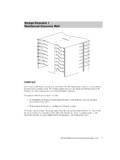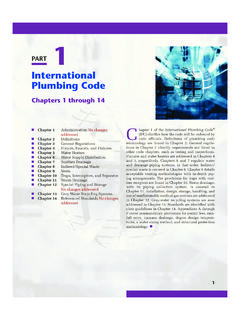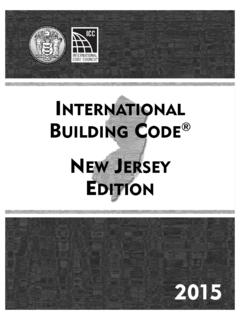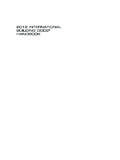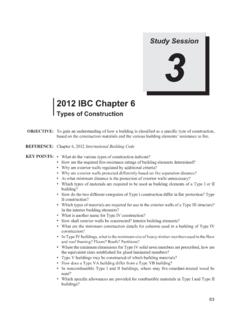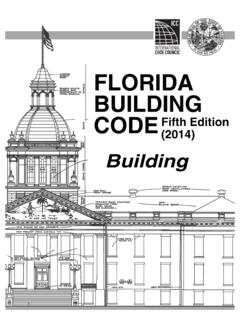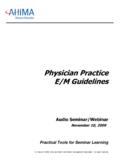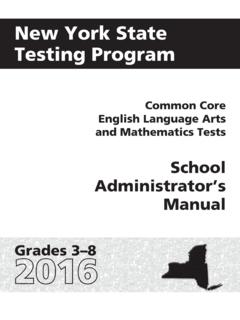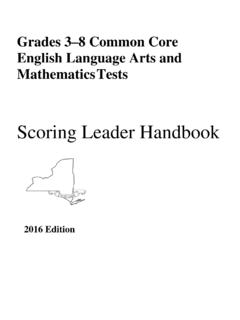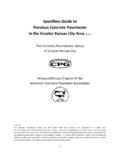Transcription of The Strength of Chapter Concrete 3 - iccsafe.org
1 Chapter Importance of Level RequiredKINDS OF , Torsion and Combined of Test Strength to the StructureMEASUREMENT OF s t i n g o f H a r d e n e d C o n c r e t eFACTORS AFFECTING Strength of Strength Variations Cement Aggregates Mix Proportioning Making and Handling the Concrete Temperature and Low Strength Development High-Early- Strength Cement Admixtures Retention of Heat of Hydration High-Temperature Curing Rapid-Setting Strength DevelopmentHIGH- Strength Concrete (HSC) Selection of Materials and and Quality ControlEARLY MEASUREMENT OF STRENGTHEXPOSURE TO HIGH ConcreteThe Strength of Concrete The Strength of Concrete 24 2015 Concrete Manual3 The quality of Concrete is judged largely on the Strength of that Concrete .
2 Equipment and methods arecontinually being modernized, testing methods are improved, and means of analyzing and interpretingtest data are becoming more sophisticated. Prior to the 2008 edition of the ACI 318 Standard, we relied almostexclusively on the Strength of 6-by-12-inch cylinders, made on the jobsite and tested in compression at28 days age for evaluation and acceptance of Concrete . The use of 4-by-8-inch cylinders for strengthevaluation was first addressed in ACI 318-08. See discussion on Strength specimens in Chapter 13, Sec-tion Importance of StrengthObviously, the Strength of any structure, or part of a structure, is important the degree of importancedepending on the location of the structural element under consideration.
3 The first-floor columns in ahigh-rise building, for example, are more important structurally than a nonbearing wall. Loading is morecritical, and a deficiency in Strength can lead to expensive and difficult repairs or, at worst, a is usually the basis for acceptance or rejection of the Concrete in the structure. The specifica-tions or code designate the Strength (nearly always compressive) required of the Concrete in the severalparts of the structure. In those cases in which Strength specimens fail to reach the required value, fur-ther testing of the Concrete in place is usually specified. This may involve drilling cores from the struc-ture or testing with certain nondestructive instruments that measure the hardness of the specifications permit a small amount of noncompliance, provided it is not serious, and may penal-ize the contractor by deducting from the payments due for the faulty Concrete .
4 Statistical methods, nowapplied to the evaluation of tests as described in Chapter 26, lend a more realistic approach to the anal-ysis of test results, enabling the engineer to recognize the normal variations in Strength and to evaluateindividual tests in their true perspective as they fit into the entire series of tests on the is necessary when computing a proposed mix for Concrete , as the contemplated mix propor-tions are based on the expected Strength -making properties of the Level RequiredThe code and specifications state the Strength that is required in the several parts of the structure. Therequired Strength is a design consideration that is determined by the structural engineer and that mustbe attained and verified by properly evaluated test results as specified.
5 Some designers specify concretestrengths of 5000 to 6000 psi, or even higher in certain structural elements. Specified strengths in therange of 15,000 to 20,000 psi have been produced for lower-floor columns in high-rise buildings. Veryhigh strengths, understandably, require a very high level of quality control in their production and test-ing. Also, for economy in materials costs, the specified Strength of very high- Strength Concrete is basedon 56- or 90-day tests rather than on traditional 28-day test results. To give some idea of the strengthsthat might be required, Table is included as information only. Remember that the plans and specifica-tions that the ACI 318 Standard (Section ) indicates a minimum specified compressive strengthof 2500 psi for structural Concrete .
6 Simply stated, no structural Concrete can be specified with astrength less than 2500 properties of the Concrete can be significant for Concrete exposed to freeze-thaw conditions, sul-fate exposure and chloride exposure (effects of chlorides on the corrosion of the reinforcing steel). Strength , however, remains the basis for judgment of the quality of Concrete . Although not necessarily Compressive Strength2015 Concrete Manual 253dependent on Strength , other properties to improve Concrete durability are related to the that fails to develop the Strength expected of it is probably deficient in other respects as : For information purposes only, the plans and specifications give actual Strength requirements for any job under OF STRENGTHG enerally, when we speak of the Strength of Concrete , it is assumed that compressive Strength is underconsideration.
7 There are, however, other strengths to consider besides compressive, depending on theloading applied to the Concrete . Flexure or bending, tension, shear and torsion are applied under certainconditions and must be resisted by the Concrete or by steel reinforcement in the Concrete . Simple testsavailable for testing Concrete in compression and in flexure are used regularly as control tests duringconstruction. An indirect test for tension is available in the splitting tensile test, which can easily beapplied to cylindrical specimens made on the job. Laboratory procedures can be used for studying shearand torsion applied to Concrete ; however, such tests are neither practical nor necessary for control, asthe designer can evaluate such loadings in terms of compression, flexure or tension.
8 See Figure StrengthBecause Concrete is an excellent material for resisting compressive loading, it is used in dams, founda-tions, columns, arches and tunnel linings where the principal loading is in is usually determined by means of test cylinders made of fresh Concrete on the job and testedin compression at various ages. The requirement is a certain Strength at an age of 28 days or such earlierage as the Concrete is to receive its full service load or maximum stress. Additional tests are frequentlyTABL E 3 .1 Strength REQUIREMENTSTYPE OR LOCATION OFCONCRETE CONSTRUCTIONSPECIFIED COMPRESSIVE Strength , PSI Concrete fill Below 2000 Basement and foundation walls and slabs, walks, patios, steps and stairs 2500 3500 Driveways, garage and industrial floor slabs 3000 4000 Reinforced Concrete beams, slabs, columns and walls 3000 7000 Precast and prestressed Concrete 4000 7000 High-rise buildings (columns) 10,000 15,000 Figure 3-1: Concrete struc-tures are subject to many kinds of loadings besides compressive.
9 (A) Com-pression is a squeezing type of loading. (B) Ten-sion is a pulling apart. (C) Shear is a cutting or slid-ing. (D) Flexure is a bend-ing. (E) Torsion is a The Strength of Concrete 26 2015 Concrete Manual3conducted at earlier ages to obtain advance information on the adequacy of Strength developmentwhere age- Strength relationships have been established for the materials and proportions size and shape of the Strength test specimen affect the indicated Strength .
10 If we assume that 100percent represents the compressive Strength indicated by a standard 6-by-12-inch cylinder with alength/diameter (L/D) ratio of , then a 6-inch-diameter specimen 9 inches long will indicate 104 per-cent of the Strength of the standard. Correction factors for test specimens with an L/D ratio less are given in the test methods for compressive Strength (ASTM C39 and ASTM C42) for direct com-parison with the standard specimen (Table ) For cylinders of different size but with the same L/Dratio, tests show that the apparent Strength decreases as the diameter increases. See Figure 3-2. Seealso Chapter 13, Section : A 6-inch core 81/4 inches long broke at 4020 = = L/D of , the factor is * Corrected Strength is then: 4020 = 3800 psi.
